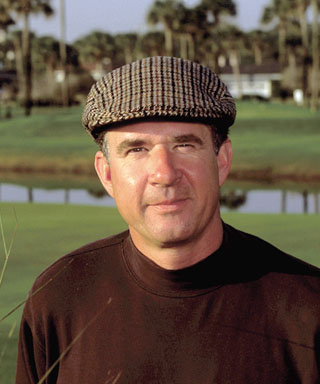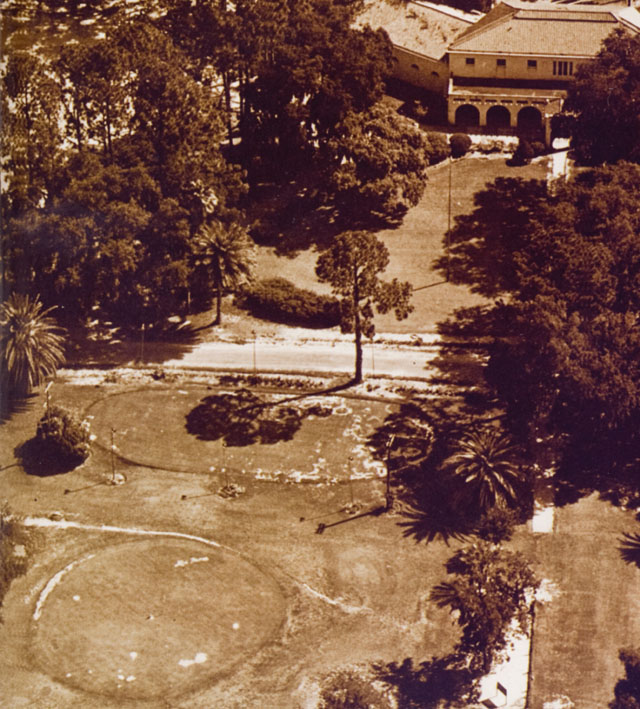|
 Those
who subscribe to the view that being a golf course architect
requires jetting about, playing golf, and rubbing elbows with
the elite, might do well to spend a day on a site with an architect
while a course is under construction. Let me reflect a few experiences
and observations from the "startover" construction
in 1996 at Timuquana Country Club. Those
who subscribe to the view that being a golf course architect
requires jetting about, playing golf, and rubbing elbows with
the elite, might do well to spend a day on a site with an architect
while a course is under construction. Let me reflect a few experiences
and observations from the "startover" construction
in 1996 at Timuquana Country Club.
Donald James Ross 1872-1948
 The
pedigree of the golf course is well documented as Donald Ross
was the architect of record in 1923. I can only assume that Mr.
Ross was favorably impressed with the site upon his initial inspection.
The property meets standards that have never gone out of favor
with views along the moss-laden, live oak banks of the St. John's
River and a native, sandy soil. Mr. Ross, who was quite prolific
in the south Georgia-north Florida area, set out to build a course
that could be favorably enjoyed by its members. The
pedigree of the golf course is well documented as Donald Ross
was the architect of record in 1923. I can only assume that Mr.
Ross was favorably impressed with the site upon his initial inspection.
The property meets standards that have never gone out of favor
with views along the moss-laden, live oak banks of the St. John's
River and a native, sandy soil. Mr. Ross, who was quite prolific
in the south Georgia-north Florida area, set out to build a course
that could be favorably enjoyed by its members.
The end result
in 1923 was a masterful, core-routed layout. Not until we uncovered
an early 40's aerial from the adjacent Naval Base did, we realize
how treeless the original golf course was. Except for a few live
oak hammocks and surrounding native vegetation, the course was
open with ample space to play. Interestingly, it appeared from
the photo that a number of green complexes were sited near these
live oak clusters, like holes' two and eleven.
With the postwar
euphoria of new technology, ( i.e., automatic irrigation, golf
carts, ball and club improvements), much of Mr. Ross' work was
redone. In the mid 50's, Robert Trent Jones was called upon to
modify the golf course with subsequent alterations by George
Cobb and Dave Gordon. This type of evolution on a golf course,
which occurs over such a long period, typically goes unnoticed.
How often do you see yourself change if you look in the mirror
every day?
While the effects
were obvious once we began to rebuild the golf course in '96,
the Naval Base aerial was the only evidence of Ross' original
intent. With such a lack of data, we believed that the only way
to properly restore the golf course was to check our ego at the
clubhouse and endeavor to see things as Ross might have seen
them.

An early 1940's aerial
photograph of Timuquana Country Club in Jacksonville Florida.
With
only fourteen weeks of actual construction to accomplish what
originally took well over a year to complete, I remember a quote
from Mr. Ross about a day in the heat at Pinehurst: "I was
plastered with dust, and looked like a coal miner!" With
a prolonged drought in the summer of '96, the entire site at
Timuquana was a dust bowl and I could certainly relate to the
"coal miner" after a twelve to fourteen hour day. We
mechanically roto-tilled the entire property, removed more than
800 trees and built a brand new golf course, start to finish
and reopened in six months.
During the clearing
process, we discovered three sets of 150-yard markers! The original
150-yard markers, now 75-foot Southern Red cedars, were discovered
approximately 60 to 75 feet in the woods, followed by a second
set of holly bushes and most recently ligustrum shrubs. Just
look to the right on hole #11. This is one of the most profound
examples of how a course evolves and matures over time.
The construction
and feel of the features on the golf course mimic what Mr. Ross
might have done. Because scoop pans, drags and lots of hand labor
was used in the 1920's, we restricted ourselves to the smallest
dozers and mechanized equipment. The flat site warranted small
features with little elevation change, hence the subtle Ross-style
bumps and fall-offs around the greens.
Where one of
Mr. Ross' associates oversaw construction and made numerous on-site
observations, we paralleled the process with intensive supervision
during the project. This could mean shaping a 'green' with our
hands in the dirt at an operator's feet or climbing on a dozer
or power rake ourselves. The best golf courses are always the
result of in-the-field creativity.
The reconstruction
of the course also solved severe infrastructure problems. Drainage
and irrigation constitute the two major components of infrastructure.
Three drainage outfalls were found and numerous open ditches
installed by Mr. Ross were reclaimed. Groundwater wells used
to irrigate in the past were abandoned and an agreement with
the adjacent Naval Base allowed the use of treated effluent to
be sprayed onto the golf course, which had up to this point,
discharged into the river.
Strategic values
worth mentioning include the balance and variety of the golf
holes. Mr. Ross was a master at alternating left-to-right and
right-to-left shots within the same hole, like at hole #17. We
have tried to implement this same concept throughout the golf
course today. An interesting note regarding the bunkers at Timuquana
is how they are offset in the strategic mode instead of penal,
or opposite each other. For example, consider the offset bunkering
at greens two, ten and twelve.
Today, the members
at Timuquana are enjoying their golf course as it continues to
evolve. The game today is different even since we upgraded the
course just six years ago. Technological advances have been a
challenge well before Donald Ross was designing and building
golf courses. I wonder what Mr. Ross would think today if he
could witness how the game is being played on his courses. For
me, I accept the challenge and continue to play in the dirt.
 |